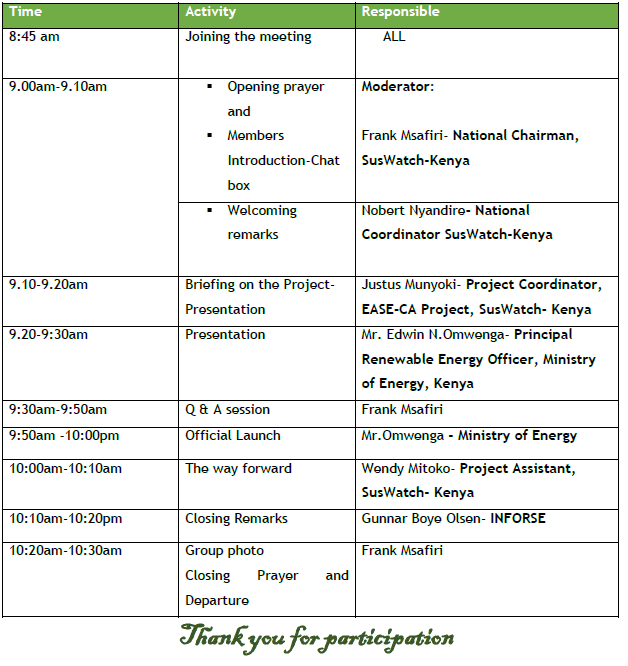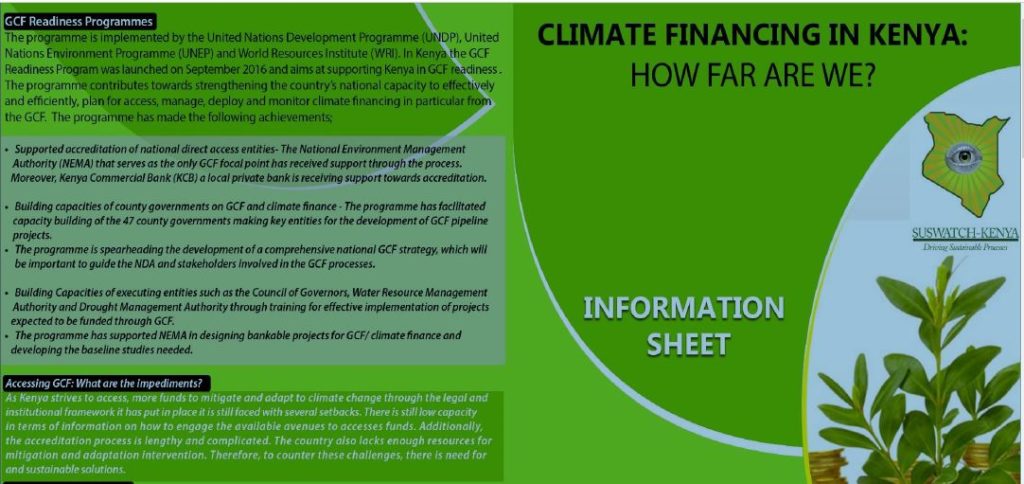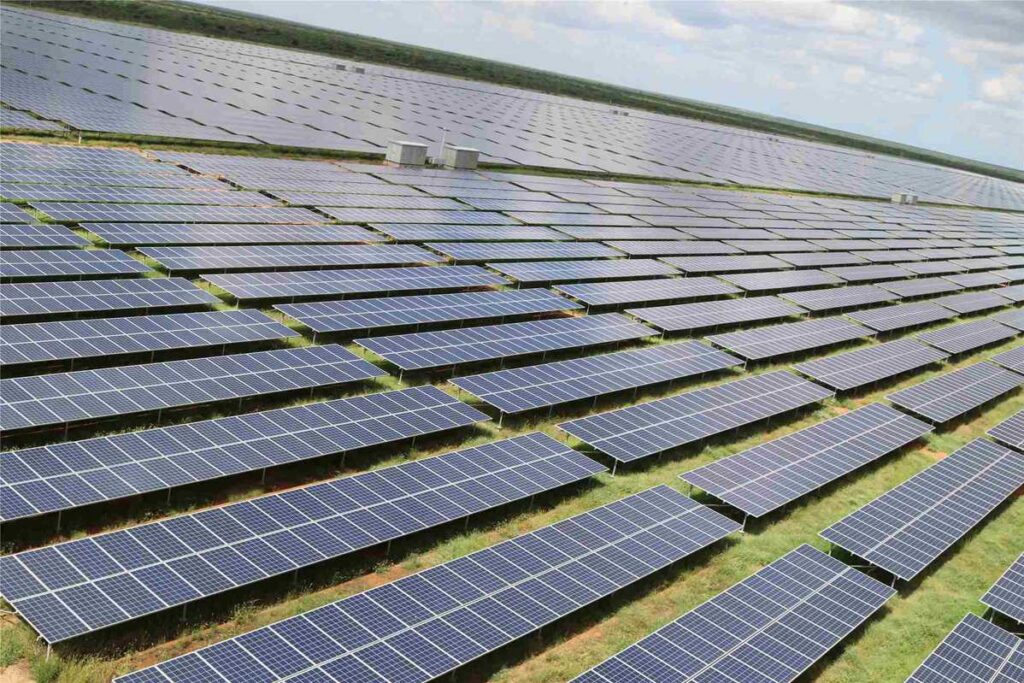PRESS STATEMENT ISSUES SURROUNDING THE NOMINATIONS TO THE NATIONAL CLIMATE CHANGE COUNCIL (NCCC)
On February 20th, 2023, it was brought to the country’s attention that the High Court in Milimani, Nairobi has suspended President William Ruto's nomination of Ms.Emily Mwende Waita, Mr. John Kioli, Ms. Umar Omar and Dr. George Odera Outa for appointment to the National Climate Change Council (NCCC).
INFORSE East Africa Position to the United Nations Framework Convention on Climate Change (UNFCCC) Conference of the Parties (COP26), in Glasgow, UK in November 2021 (October 19, 2021)
We the Civil Society Organisations under the umbrella of the International Network for Sustainable Energy (INFORSE East Africa) coordinated by SusWatch Kenya, TaTEDO - Centre for Sustainable Energy Services, Tanzania, and Uganda Coalition for Sustainable Development would like to share our position ahead of the 26th Conference of Parties (COP26) to the United Nations Framework Convention on Climate Change (UNFCCC), due to take place in November 2021, in Glasgow, UK.
How Kenya can become 100% Renewable Policy Brief
Energy is the lifeblood of all societies. But its production from burning of fossil fuels produces carbon dioxide emissions that are released into the atmosphere on a grand scale. Energy sector accounts for more than 70 percent of total global greenhouse gas emissions, which are driving climate change worldwide. Reducing Carbon Dioxide emissions from the energy sector has a direct and positive impact on climate protection. So there needs to be a transition from the current energy system that relies heavily on fossil fuels to a system that uses renewable energy sources, such as wind, geothermal and solar. Also the use of biomass must be coupled with innovations to enhance sustainability.
Local Sustainable Solutions in East Africa
National Launching of the EASE-CA catalogue of local Sustainable Solutions for Kenya virtually via zoom.The EASE-CA Catalogue presents local solutions which are popular in East Africa used by at least more than 1000 people and is composed of 45 cases available electronically for mobile appliances (phones and computers) online http://www.localsolutions.inforse.org/ INFORSE
Sustainable Energy News
It is promising to see that large countries are stepping up climate ambitions around the world in China, India, and the USA (the upcoming administration) as well as EU countries. One concern, however, is that some of the plans to realise the climate targets are based on large-scale centralised solutions including carbon capture and storage (CCS). To reduce emissions as much as needed, we need large popular involvement as well as regulation and programs to support local solutions.
We also need to help each other to step-up community resilience and adaptation to climate change. The Covid-19 pandemic has opened our eyes – wide – to the stark gap in sustainable energy supply at the time of crisis. People around the world are quarantined at home, and poor people in many developing READ MORE ! Sustainable News
100% Renewable Energy Plan for Kenya by 2050
This report gives an overview of the Kenyan situation regarding energy supply and demand , and presents a scenario for how Kenya can move into a 100% renewable energy economy until 2050 and at the same time move from a lower middle income country into an upper middle income country as well as reduce biomass use for energy to sustainable levels. Kenya has vast potentials for renewable energy and has been ranked fifth globally in an annual Bloomberg index measuring investments and opportunities in clean energy, two facts that together give a good basis for realizing a development as described in the 100% renewable energy scenario in this report.
The report focuses on how to supply the energy for Kenya’s development with renewable energy and how to Increase energy use with modern, energy efficient technologies. In addition to the scenario for transition to 100% renewable energy, the report also includes a business as usual scenario for how Kenya might develop without focus on renewable energy. A comparison of the cost of energy supply of the two scenarios shows an economic benefit of the renewable energy scenario.
The report explains specific proposals that lead to 100% renewable energy development. Link to 100% Energy Plan for Kenya by 2050.
Summary of Renewable Energy Scenario in Kenya

How Kenya can become 100% renewable
How will Kenyas energy demand and system develop?
How can energy efficiency help to meet demand?
What renewable energy sources can energise Kenya?
How can Kenyas biomass use become sustainable?
What will it cost?
Population grows, from 53 mill. today, to (maybe) 91 mill in 2050
GDP continue to grow, 5,7%/year in average, GDP 5 times bigger in 2050
than in 2020
Demand for cooking, transport, light, industry etc. will grow with
population and GDP
Publication Link: Summary of Renewable Energy Scenario in Kenya
Presentation by SusWatch on 100% RE During the Launch on September 3 2020

SusWatch Kenya has been engaging in the promotion of pro-poor low emission development strategies in East Africa. This has been primarily through promoting community level best practices in the energy sector while in tandem, pushing for policy implementation and ensuring the Civil Society voice is considered in decision making processes.
Currently, the organization is implementing a project, alongside Tanzania, Uganda and Denmark on promotion of sustainable energy and climate solutions in East Africa.
qThe immediate objective 1: Empower poor, rural communities in three districts in Uganda, and in East Africa more generally, to get access to clean energy and improved livelihoods in an economic and climate friendly way, as well as to refine methods from previous projects to realize this.
Publication Link: 100% Renewable Energy Plan for Kenya
Presentation by MoE During the Launch of 100% Renewable Energy -September 3 2020

Kenya is a leader in economic growth in Sub
Saharan Africa
Key Indicators, 47.56 million population,US$70 billion Gross Domestic Product (GDP), 5% average annual economic growth,Economy primarily composed of agriculture,
forestry, tourism, mining and energy sectors, US$1,750 GDP per capita, 569,140 sq km of land, 47 Counties
Publication Link: MoE Presentation during the Launch of 100% renewable energy
Virtual Official Launch Event Program for 100% Renewable Energy Plan for Kenya by 2050

The overall objective of this project is increased access to sustainable energy and other climate solutions to local communities in Uganda, Kenya and Tanzania with both women’s and men’s full and effective participation and leadership for improved livelihoods and reduction of poverty. This will be realized by combining Civil Society Organization (CSO) activities on local, national and international levels in ways, where they reinforce each other. The project primarily works towards Sustainable Development Goal (SDG) 1 (poverty), SDG5 (gender), SDG7 (clean energy), SDG 13
(climate action), SDG 17 (partnerships). The immediate objective 1: Empower poor, rural communities in three districts in Uganda, and in East Africa more generally, to get access to clean energy and improved livelihoods in an economic and climate friendly way, as well as to refine
methods from previous projects to realize this.
The immediate objective 2: Strengthen national CSO networking and advocacy for increased targets and financing of local, sustainable, pro-poor, and gender responsive climate and energy solutions in national development strategies and their implementation in Kenya, Tanzania, and Uganda. The strategies shall include Nationally Determined Contributions (NDCs) and Long-term
Publication Link: Virtual Event Program for 100% RE Plan for Kenya by 2050
Statement by the MoE During the Launch of 100% Renewable Energy
Energy is critical to the realization of Kenya’s Vision 2030 which seeks to transform Kenya into a newly industrializing middle-income country providing a high quality of life to its entire citizenry. Further, the Government’s “Big 4 Agenda” comprising of Food and Nutrition, Security, Manufacturing, Affordable Housing and Healthcare, unveiled by the President in 2017, is dependent on provision of adequate and competitively-priced energy. Consequently, the government has over the last few years embarked on an ambitious journey to provide access to competitively-priced, reliable, quality, safe, and sustainable energy. Tremendous achievement in scaling.
Publication Link: Statement by MoE during the launch of 100% Renewable Energy
Policy Brief: Importance of pro-poor focused NDCs/LEDS in East Africa

The negotiations currently ongoing at the 46th session of the Subsidiary Body of Implementation (SBI) and the Subsidiary Body for Scientific and Technological Advice (SBSTA) and the 3rd Ad Hoc Working Group on the Paris Agreement are a continuation of the negotiations which kicked off during the COP22 session in Marrakech, Morocco in 2016. The negotiations are covering matters of development of the Paris rule book, transparency, accountability, finance of the NDCs and the development of guidelines of the NDCs.
Publication Link: PIPA Policy brief May 2017 Bonn with date
SDG7 Implementation Scenario in Kenya
Improved access to energy sources especially electricity improves human development conditions through provision of water; industrial and agricultural productivity; disadvantaged groups empowerment; better health and education conditions and environmental sustainability. In view of that, universal electricity access remains one of the drivers of social economic development in Kenya.
Equally, access to affordable, competitive, reliable, quality, safe and sustainable energy remains an integral part in the achievement of the “Big 4 Agenda”. As such, development of the energy sector is critical if Kenya is to achieve the Kenya Vision 2030 and become a newly industrializing, middle income country. Kenya possesses significant potential sources for clean and affordable power generation in geothermal, wind, hydro and biomass energy.
3.0 SDG7 implementation Milestones in Kenya.
Publication Link: SDG7 Implementation Scenario in Kenya
Nationally Determined Contributions (NDCs) Implementation: The Kenyan Scenario
Nationally Determined Contribution (NDCs) are the actions and targets that countries have signaled they will undertake to help keep global temperatures from rising more than 2 degrees Celsius. The INDCs are not legally binding commitments, however; they ultimately play a critical part in determining whether the world achieves an ambitious 2015 agreement thus it is put on a path toward a low carbon, climate-resilient future.
Kenya submitted its Intended Nationally Determined Contribution (INDC) in 2015 as part of its obligations as a signatory and party to the United Nations Framework Convention on Climate Change (UNFCCC). Following the unexpected early entry into force of the Paris Agreement (PA) in November 2016, all INDCs became anchored in the PA as five-year NDC iterative cycles. When Kenya submitted its ratification instruments in December 2016, it confirmed its earlier submitted INDC to be its NDC. As such all, the information contained in its now Nationally Determined Contribution (NDC) remain current, which reiterates that adaptation is Kenya’s priority response to climate change.
Publication Link: Kenya NDCs Implementation Scenario
The East Africa Regional Baseline Report - PIPA project

This report was drafted in March 2017 and published in May 2017 in line with the UNFCCC 46th Session of the Subsidiary Body of Implementation (SBI) / Subsidiary Body for Scientific and Technological Advice (SBSTA) and the 3rd Ad hoc Working Group on the Paris Agreement (APA), which is organized for the purposes of continuing the negotiations from the COP 22 in Marrakech Morocco from the 8th- 18th May, 2017.
The PIPA implementing team seeks to have the recommendations on NDC implementation and LEDS development processes from the Regional and National Baseline reports are shared with key decision makers during this session.
Publication Link: Regional baseline full report 1_0
Kenya Natioanal Baseline Study- PIPA project

Kenya is already feeling the effects climate change. The widespread poverty, recurrent droughts, floods, inequitable land distribution, overdependence on rain-fed agriculture, and few coping mechanisms all combine to increase people’s vulnerability to climate change. For instance, the affected people have little security against intense climatic impacts. They have few resource reserves, poor housing and depend on natural resources for their livelihood. Floods and droughts have caused damage to property and loss of life, reduced business opportunities and increased the cost of transacting business in the country. In response to the challenges posed by Climate Change, Kenya has developed a National Climate Change Response Strategy (NCCRS 2010), National Climate Change Action Plan (NCCAP 2013), Climate Change Act (2016), and a National Adaptation Plan (NAP), which provides a vision for low-carbon and climate resilient development pathway. Kenya is operationalizing these policies and plans through the implementation of climate change actions in various areas such as afforestation and reforestation, geothermal and other clean energy development, energy efficiency, climate smart agriculture, and drought management. Publication Link : Kenya National Baseline Study – Pipa Project
Climate Financing in Kenya, How Far are We

Promoting Climate Change Mitigation Initiatives in Western Kenya

Farming in the Face of Climate Change

Farmers have had to adapt to the conditions imposed on them by climate of their region since the inception of agriculture, but recent human -induced climate change is throwing them some unexpected curve balls. Extreme heat, floods, drought, hail and windstorm are some of the direct effects. In addition, there are changes in weed species and distribution, and pest and dieases pressure, on top of potenetially depleted soils and water stress.
Fortunately, there are many practices that farmers can adopt and change that can be made to our agricultureal production system to make the system more resilient to our changing climate.
Publication Link: DaCCANews







